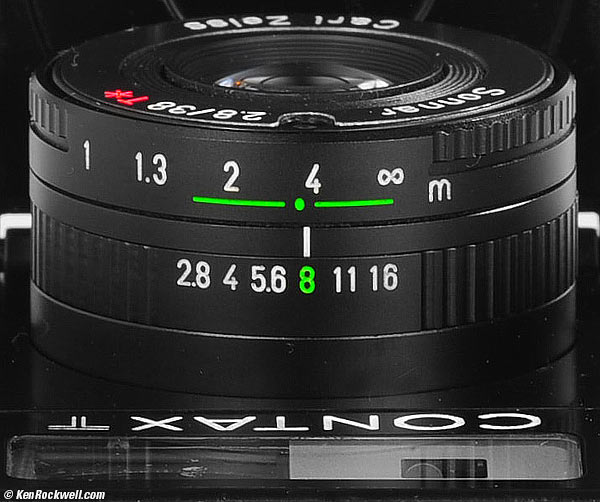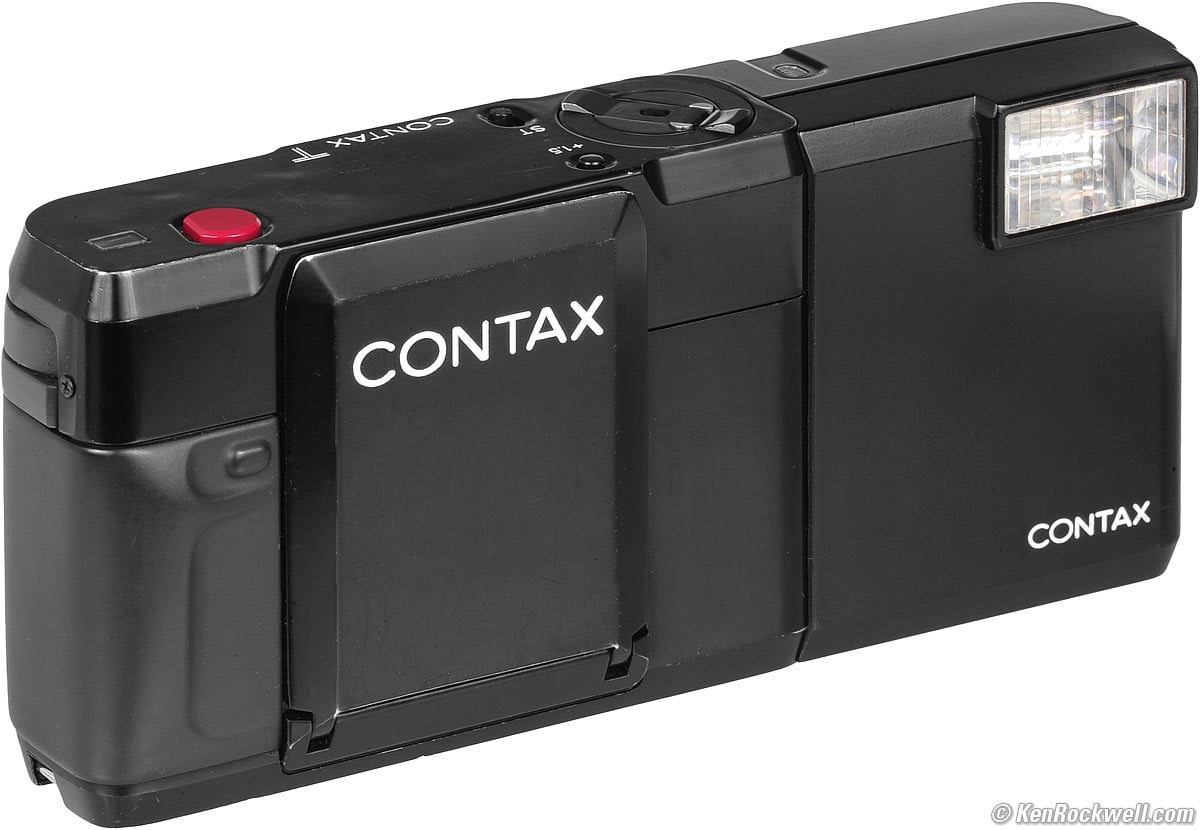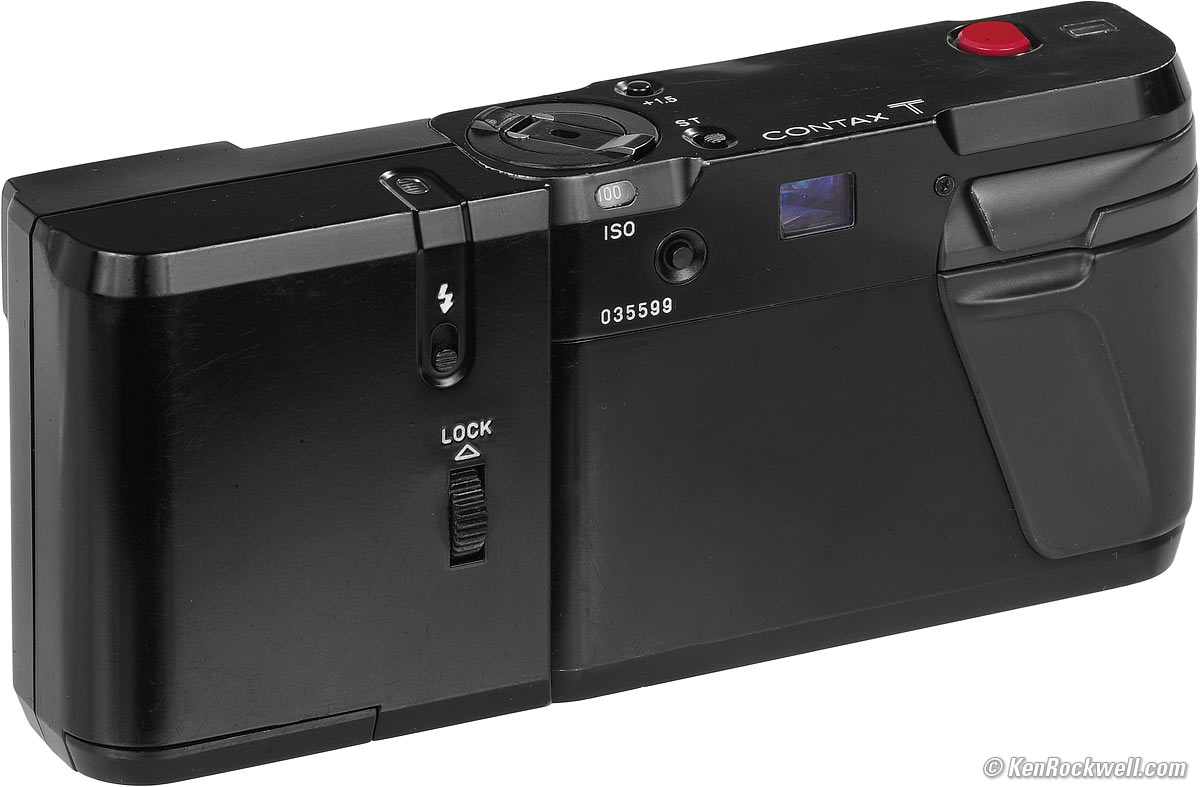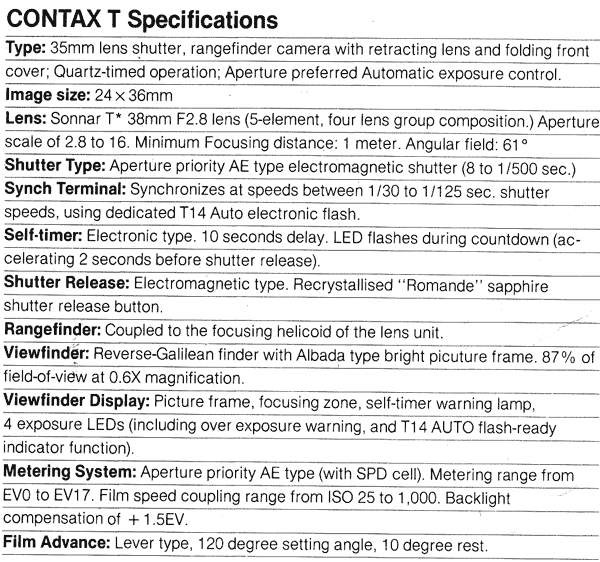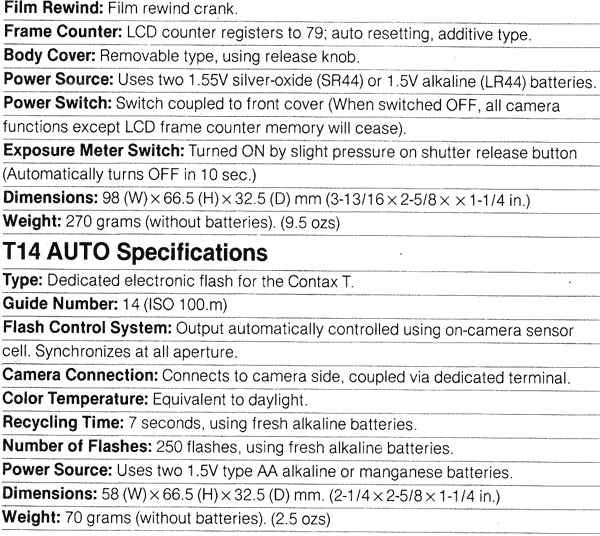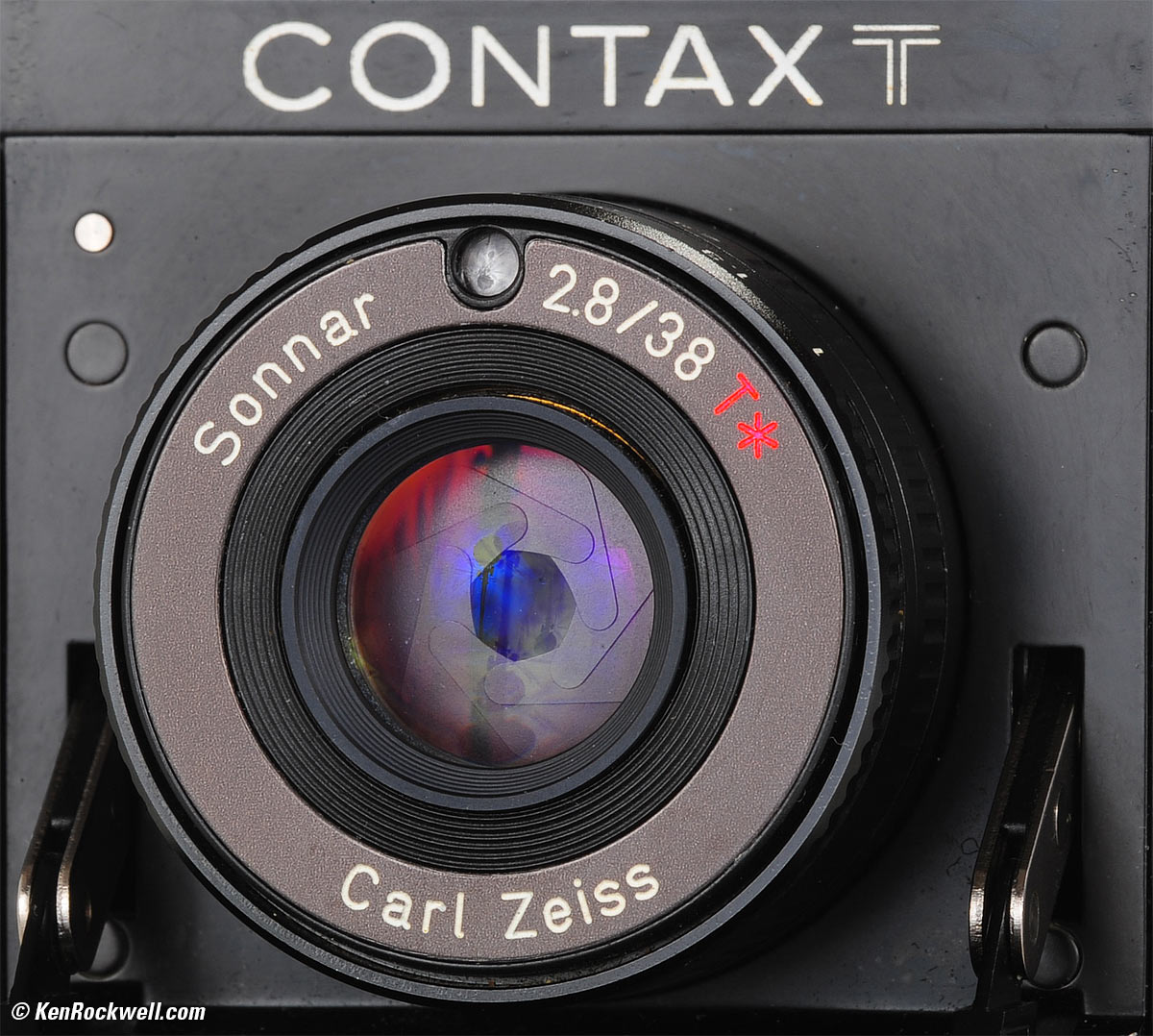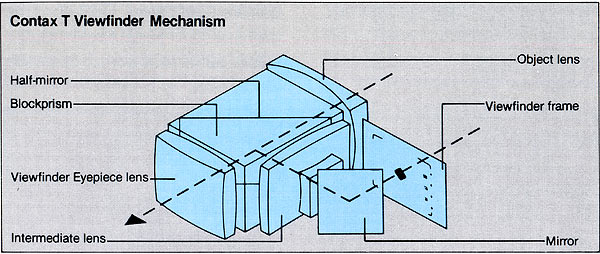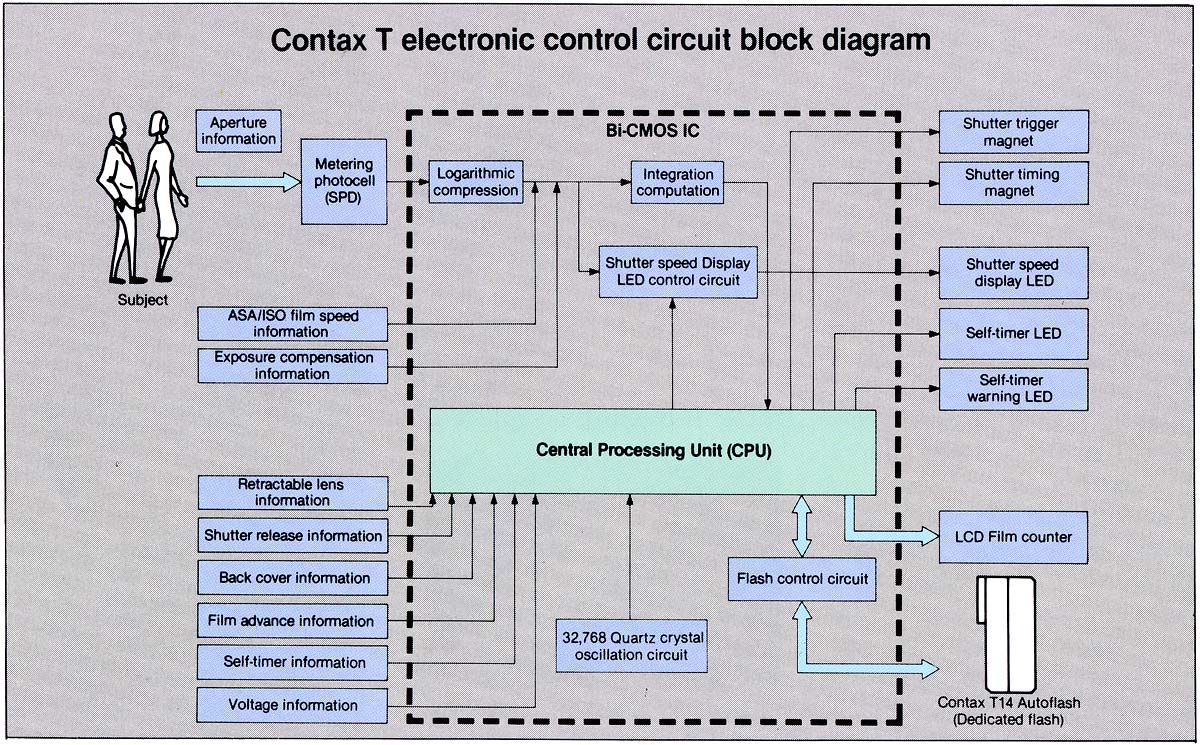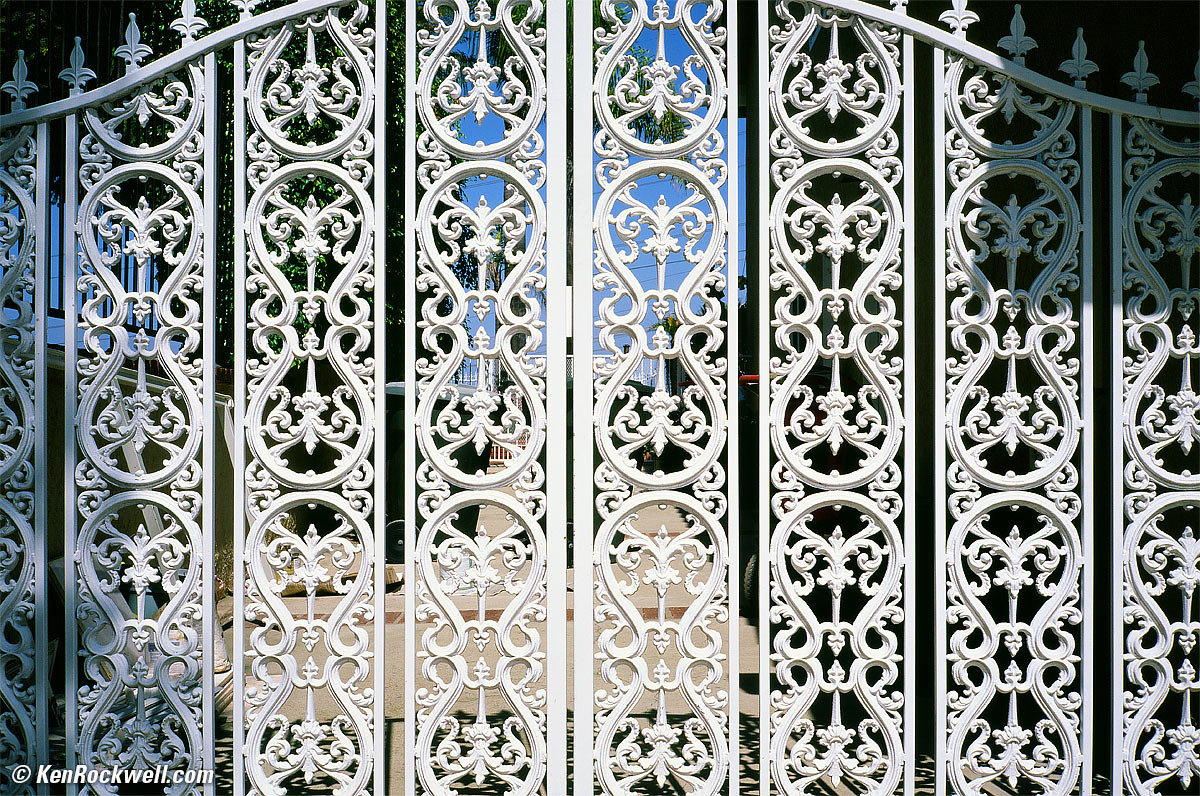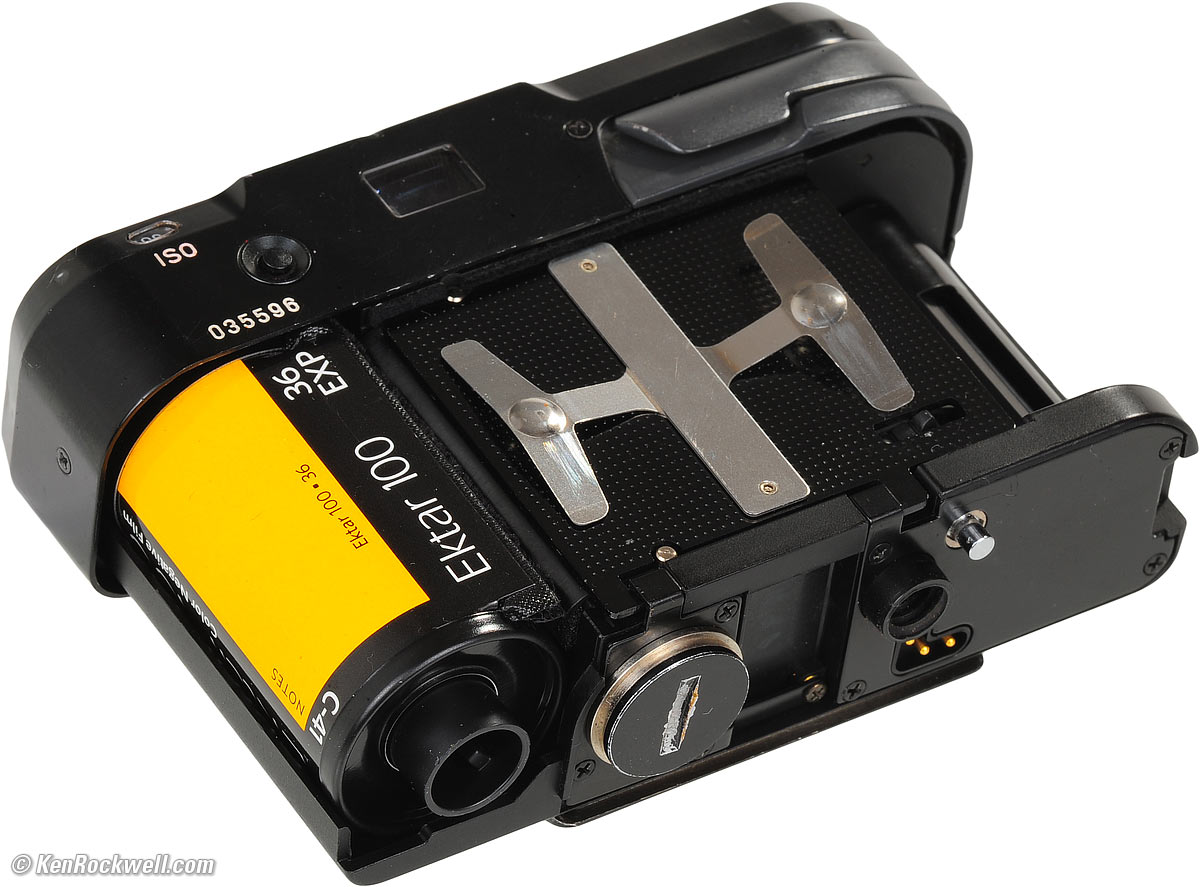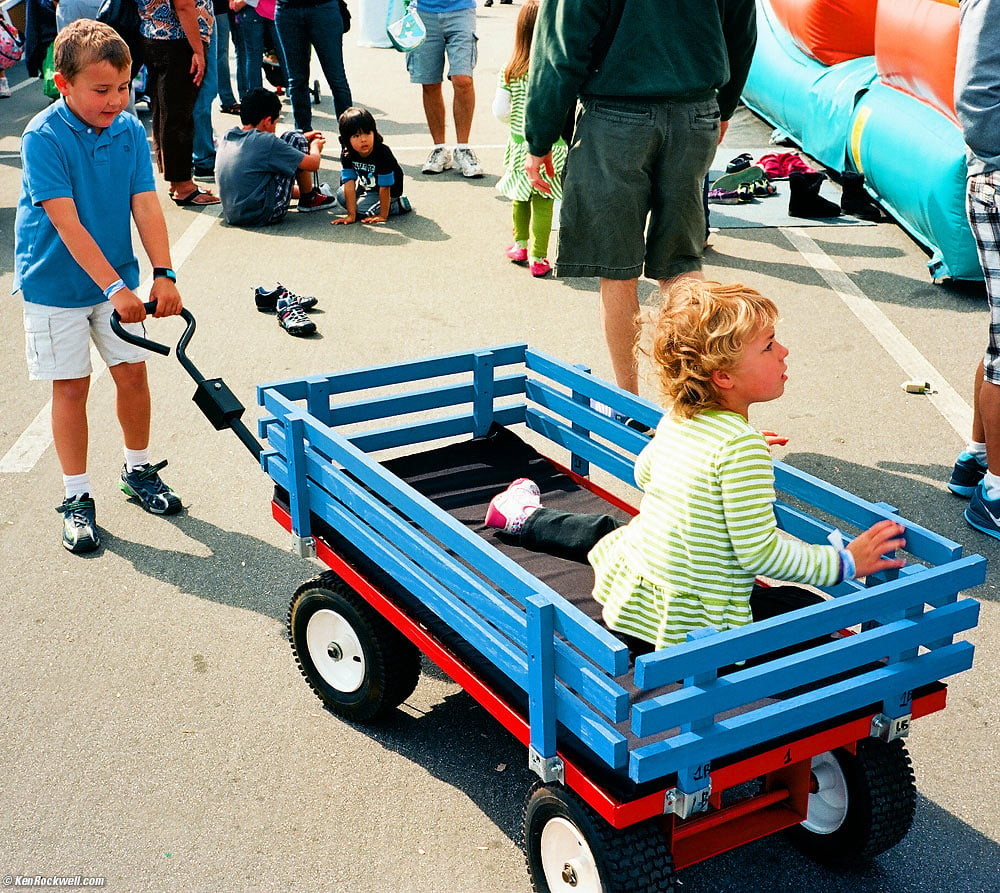Home Donate New Search Gallery Reviews How-To Books Links Workshops About Contact
CONTAX T
35mm Rangefinder (1984-1987)
Intro Specs Performance Compared Usage Recommendations More
CONTAX T (no filter thread, 10.6 oz./300g with film and batteries, 3.2'/1 m close focus, about $500 used). enlarge. My biggest source of support is when you use any of these links, especially this link directly to them at eBay (see How to Win at eBay), when you get anything, regardless of the country in which you live. It helps me keep adding to this free website when you get yours through these links — but I receive nothing for my efforts if you buy elsewhere. Please always use these links when getting any of your gear so I can continue to review these uncommon cameras. Thanks for your support! Ken.
July 2022 CONTAX reviews Nikon Canon Fuji LEICA All Reviews
Top, CONTAX T. enlarge.
Sample Images
Dildoplant, 15 April 2013. (CONTAX T, Fuji Velvia 50, f/4 at 1/125, 1 meter focus, 9:37 AM, NCPS process and scan, Athentech Perfectly Clear plug-in.) © 7 MB JPG full-resolution scan.
Crop from above scan. See the dewdrops! If this is 6" on your screen, the complete image would be 50 x 35" (1.5 x 1 meters) printed at this same magnification!
15 March 2013. The only thing in focus is the middle of the picture due to finite depth of field at f/2.8. The subject's own light fell-off at the sides; it's not lens falloff. (CONTAX T, Kodak EKTAR 100, f/2.8 at 1/60, 1 meter, 4:56 PM, no flash, NCPS process and scan, Athentech Perfectly Clear plug-in.) bigger.
Introduction top
Intro Specs Performance Compared Usage Recommendations More
The CONTAX T is a very high-quality compact 35mm camera. It is a rangefinder manual focus, manual-wind camera with an automatic electronic leaf shutter.
It was styled by Porsche Design and made by Kyocera as a rich man's vacation camera.
The CONTAX T is an exquisitely well-made all-metal camera, with a synthetic ruby shutter button, a ball-bearing film winding shaft and a titanium film advance lever. It had a list price, corrected for inflation today in 2013, of $1,200.
I show a black one here; it usually came in silver.
The CONTAX T has a folding metal bed with a fixed 38mm f/2.8 Carl Zeiss Sonnar T* lens, aperture-priority auto exposure electronically-controlled from the SPD (Silicon Photo-Diode) on the front of the lens.
Focus is by turning the front of the tiny lens, and apertures are selected on a click-stopped aperture ring. Any aperture between the full-stop clicks works just fine.
The shutter is steplessly quartz-controlled, but the finder has only four LEDs (Light-Emitting Diodes) to give a rough idea of shutter-speed. It all runs on two A76 cells for a very long time.
The frame counter is an LCD (Liquid-Crystal Display) on top. It turns off a few seconds after the camera is closed. It read up to 79 frames, making it ideal for use with Ilford's 72-exposure rolls of film produced on a special extra-thin base.
As a very compact camera just big enough for the supply and take-up spools (and the film gate, see it with the back open under Usage), I get 40 good frames on a 36-exposure roll of Kodak EKTAR 100.
The included, dedicated A14 AUTO flash makes it much bigger. This is the only flash that works with the dedicated coupling of the CONTAX T.
The only things missing are an auto-exposure lock (no big deal, use the +1.5 stop compensation switch), no way to mount filters, no real battery check (the manual says if the meter stops working, change the batteries), no way to get slow flash sync, and no parallax or magnification compensation as focused. That's OK, no LEICA camera has ever had focus-distance compensation for magnification, either.
CONTAX T lens controls.
I find the 3.2 feet/1 meter close focus distance stifling. With a 38mm lens, I often want to get closer, but other than that, the CONTAX T is a marvelous camera with a great lens and great ergonomics.
CONTAX T with A14 AUTO Flash.
Rear, CONTAX T with A14 Flash. enlarge.
Specifications top
Intro Specs Performance Compared Usage Recommendations More
Lens
Carl Zeiss Sonnar 38mm f/2.8 T* lens diagram.
Carl Zeiss Sonnar 38mm f/2.8 T*.
5 elements in 4 groups.
T* multicoating.
Angle of view: 61º.
Close Focus: 1 meter (3.2'). 1:23.4 reproduction ratio.
Diaphragm
Carl Zeiss Sonnar 38mm f/2.8 T* lens. enlarge.
7 straight blades.
Full-stop clicks to f/16.
Focus
Manual-focus, superimposed rangefinder in the finder.
CONTAX T rangefinder diagram.
Viewfinder
87% coverage, 0.60x magnification.
CONTAX T viewfinder diagram.
Live View
Always active, no battery power required.
Shutter, Exposure and Light Meter
Meter sets to ISO 25-1,000.
SPD on front of lens.
Computer-controlled:
CONTAX T on-board computer systems diagram. enlarge.
Shutter speed range: 1/500 to 8 full seconds (EV 0 ~ 17).
Maximum speed with flash: Rated 1/125, but seems more like 1/250 as indicated in the finder.
T14 AUTO Flash
CONTAX T with A14 AUTO Flash.
The A14 AUTO flash is included, and is the only flash that will sync or mount to the CONTAX T.
The flash's exposure is also controlled by the SPD above the lens. The flash's output varies based on set ISO, aperture and light reflected from the subject. The recycle time is always the same; it doesn't use a thyristor.
Sync speed is rated at 1/125, but seems more like 1/250 as indicated in the finder.
The flash is rated at GN 9 meters (30 feet) at ISO 100.
Contax rates it as 7 second recycle.
It runs on two AA cells, Alkaline or those crummy "heavy duty" manganese. Ni-Cds aren't recommended, but work fine.
The flash performs better than these ratings.
Shutter
1/500 to 8 full seconds.
Quartz-crystal timing.
The shutter is a five-blade electronic leaf, much fancier than other compact cameras which use just two "scissors" blades to control both aperture and shutter speed together.
Power
Two S76 cells. (A76, LR44, SR44 etc. are all fine to use.)
Quality
Designed by Porsche in Germany.
Made in Japan.
Environmental
"Normally operates from" -10º C to 50° C (14º to 122º F), but the batteries may not be happy about it afterwards.
Size
Rated 3-13/16 x 2-5/8 x 1-1/4" WHD.
Rated 98 x 66.5 x 32.5 millimeters WHD.
Flash rated 2-144 x 2-5/8 x 1-1/4" WHD.
Flash rated 58 x 66.6 x 32.5 millimeters WHD.
Weight
10.590 oz. (300.2g), camera measured with film and batteries.
14.990 oz (424.9g), camera measured with T14 AUTO flash, all batteries and 36-exposure film.
T14 AUTO flash only, with two AA alkaline cells: 4.400 oz. (124.7g).
Case only: 1.185 oz. (33.7g).
Camera, flash, batteries and film in case: 16.175 oz. (458.6g).
Camera (only) in case with batteries and film: 11.780 oz. (333.9g).
Contax specifies 9.5 oz. (270g) for the camera, empty, and 2.5 oz. (70g) for the flash, empty.
Included
CONTAX T camera.
CONTAX A14 AUTO Flash.
Genuine lines suede case with two magnetic catches, one for just the camera, and one for the camera with the flash attached.
CONTAX T red-lined suede case as seen in 2013. enlarge.
Price, USA
June 2022: About $500 used.
March 2013: About $350 used.
1984: $560 list price new, $319 new at B&H. (with inflation in 2013, that's the same as $1,200 and $688!)
Sample Image
Racing Lego cars with Ryan, 15 March 2013. (CONTAX T, Kodak EKTAR 100, f/2.8 at 1/60, 1 meter, 4:56 PM, no flash, NCPS process and scan, Athentech Perfectly Clear plug-in.) bigger. (Ryan moved.)
Performance top
Intro Specs Performance Compared Usage Recommendations More
Overall
The CONTAX T is a small Porsche-design camera with great performance! You can't go wrong with the CONTAX T.
Finder
The little finder is swell.
The four LEDs for shutter speed are all I need. There's one for OVER 500, one to tell you you're in the 500-125 range, a second for 125-30 range, and a fourth to tell you that you're going to have a shutter speed slower than 1/30.
The slow shutter LED won't blink to tell you if the light is so low that you need more than an 8 second exposure. (Blinking LEDs mean the flash is ready.)
I don't like that the shutter speed indications are inside the active frame on the right, but too bad.
The meter has extremely fast temporal response, like the LEICA M7. If you point the camera at a light that flickers or a fan, you may see more than one LED lit as the indication flickers to match the instantaneous values of your subject.
There is a BIG RED LED that lights when the self timer is active.
Focus
The rangefinder is bright and contrasty. It's easy to focus fast and precisely.
The tiny little lens ring is well damped; it's a bit slow to move, but it won't drift on you either.
Loading and Winding
Loading and winding are easy.
The LCD counter counts to 79!
The tiny titanium wind lever works great, and even has 10º of stand-off if you like.
Shutter
The leaf shutter and mechanism are quiet, but not silent.
The trigger pull (shutter release feel) is a bit long and mechanical feeling for an electronic camera, probably designed that way to feel more like the mechanical releases common in its day.
Lens
Duh, of course it's super sharp. What were you expecting, Sigma or Tamron? Remember, this was a $1,200 camera.
The Carl Zeiss Sonnar 38mm f/2.8 T* also has no visible distortion. At 3 meters (10 feet), use a coefficient of +0.55 in Photoshop's Lens Correction Filter to correct it.
There is very little light falloff, even at f/2.8.
If shooting lawn furniture or dead trees against gray skies is your thing, there is a tiny bit of orange-blue lateral color.
The 7-blade diaphragm begets 14-pointed sunstars.
White Gate, 23 March 2013: No Lateral Color, YAY! CONTAX T, Fuji Velvia 50, f/8 at 1/250, 3.6 meters focus, 11:40 AM, NCPS process and scan, Athentech Perfectly Clear plug-in.) bigger.
The CONTAX T is easy to figure out, to use and to hold, but it's a bear trying to press the top +1.5 EV exposure compensation button at the same time as taking a picture!
The case is more of a dust cover; it has no belt loop. It is a luxuriously soft case and not intended to hold the camera, it serves to protect it against scratches and dust.
It seems pretty big with the flash attached, but the two connected together inside the case easily fit in a front packet of my cargo shorts.
The special rewind crank doesn't rotate, meaning it will never hang-up in your hand while shooting vertically.
The only way to use flash with the CONTAX T is to use the dedicated T14 AUTO flash.
The flash measures better than rated, but the system's overall flash exposure performance is uninspiring.
While only rated at GN 9 meters (30 feet), I measure GN 12 meters (40 feet) at ISO 100. Most flashes measure a stop less than rated, and the T14 AUTO measures more than rated, bravo!
Recycle time is also much better than rated, at only 4.4 seconds with fresh alkalines or Ni-MH. There is little to no noise from the flyback transformer.
It always takes the same amount of time to recycle regardless of light output; the T14 AUTO lacks thyristor circuitry.
The flash itself is fine, but the way that the camera controls the exposure is primitive.
There is no slow-sync; the camera only goes as slow as 1/30 in dark light, giving the usual indoor flash pictures against totally black backgrounds.
Daylight fill can work, but the flash arbitrarily doesn't fire above about 1/125 of a second. The manual says it won't fire above 1/125, and on my CONTAX T, it will fire up to about an indicated 1/250 second.
No, I have no idea why flash sync is so slow. With a leaf shutter, it ought to sync to 1/500, and would help make for great daylight fill if it did.
As-is, the flash adds little value, especially considering that it's almost as big as the camera alone.
The flash has no auto-off or power-saving function. When on and idle, it draws 120 mA, which calculates to about 19 hours or idle time on alkaline, 20 hours with 2,600 mAH Ni-MH, or 16.7 hours with 2,000 mAH Eneloop.
Ryan at the park, 02 April 2013. (CONTAX T, Fuji Velvia 50, A14 AUTO FLASH ON, f/8 at 1/200, 1 meter focus, 3 PM, NCPS process and scan, Athentech Perfectly Clear plug-in.) bigger.
Mechanics
The camera's exterior is all metal. The flash is all plastic.
The lens' identity ring is engraved metal, but it's merely glued onto the plastic inner lens body, and sometimes falls off and gets lost.
Film Economy
I get 40 good frames on a 36-exposure roll of Kodak EKTAR 100!
Sample Image
Diner. (CONTAX T, frame 38 of a roll of Kodak EKTAR 100, f/2.8 at 1/60, 1 meter, 4:56 PM, no flash, NCPS process and scan, Athentech Perfectly Clear plug-in.) bigger.
Compared top
Intro Specs Performance Compared Usage Recommendations More
I prefer the Nikon 35Ti, which sells for about the same price in 2013. Both are compact ultra-high quality titanium-cased cameras, but the Nikon sold for even more money in its day.
The 35Ti has a built-in flash which has pure genius for fill-flash and slow-sync exposures, all lacking with the huge accessory T14 AUTO on the CONTAX T.
The 35Ti also focuses two and a half times closer, so I'm never stuck out at the CONTAX
1-meter (3.2 feet) close-focus distance.
The 35Ti runs on a CR123 lithium cell, more expensive than the two A76 cells of the CONTAX T, and the 35Ti, with its motorized film advance and rewind, runs that battery down sooner.
The CONTAX T gives 40 shots on a roll while the 35Ti auto-winds ahead a couple of frames for only about 38 frames on a roll.
The 5-element Carl Zeiss Sonnar 38mm f/2.8 T* of 1984 is a great lens, but the 6-element double-Gauss 35mm f/2.8 NIKKOR from 1993 of the 35Ti is even better. Both have 7-blade diaphragms.
The Nikon also adds autofocus as well as manual focus, and manual and Time exposures over the CONTAX T.
At the park, 02 April 2013. (CONTAX T, Fuji Velvia 50, A14 AUTO FLASH ON, f/8 at 1/200, 2 meters focus, 3:14 PM, NCPS process and scan, Athentech Perfectly Clear plug-in.) bigger.
Usage top
Intro Specs Performance Compared Usage Recommendations More
See also the CONTAX T Users Manual.
The CONTAX T is very straightforward to anyone who knows how to use a real camera.
Bottom, CONTAX T with A14 Flash. enlarge.
Power and Batteries
Two S76, A76, LR44 or SR44 cells go in the bottom.
There's no real battery check. The manual says if the meter LEDs stop working, change the batteries!
The CONTAX T ought to run for years on a set, and it's trivial to keep a spare pair in your wallet.
The meter comes on for a while after the shutter is pressed.
The frame counter shows only when the bed is open.
The frame counter is non-volatile, meaning it remembers where you were when you change the batteries.
Opening the camera
Just flip-down the front bed.
Press the little rubber nub on the body near the big C in CONTAX to open the bed just enough so you can slip a fingertip under the bed.
Loading and Winding
Remove the flash.
Fold open the lens. Don't load with the camera closed.
Slide the LOCK switch forward and slide open the camera into two pieces.
CONTAX T. enlarge.
Flip up the film pressure plate, and insert the film leader into a slot.
Most people will wind a frame to be sure it's working, but I prefer to close the camera first to get an extra frame. I load, and just shoot after the first dead frame. I don't wait for 01 to show on the counter, I start shooting while it still reads "--."
The rewind crank is a special Porsche design that doesn't move as the film is advanced. To be sure your film is advancing properly, look for the rotating white line inside the rewind crank.
To set the ASA ("ISO"), press the rear button and turn what looks like the rewind crank.
You can't test-fire with the camera open. The German engineers designed special electronic contacts in the base that you can't cheat. It won't let you fire unless it's all buttoned up.
Easy Point-and-Shoot Shooting
CONTAX T lens controls.
If you don't want to diddle with any settings, just set it as shown to the green f/8 and the dot at 4 meters. Now just about everything will be in focus in the green zone from 1.5 meters to infinity and well exposed, assuming you use the flash indoors.
Focus
Just turn the front focus ring while looking in the finder to match the superimposed images in the center.
Exposure
It works great with print film or even picky slide films like Fuji Velvia 50, with great colors, perfect exposure and all my slides are very, very sharp.
Turn the aperture ring as desired. f/8 is perfect outdoors, use f/4 or f/5.6 in shade, and use f/2.8 indoors without flash.
You'll see LEDs in the finder for the rough shutter speed.
The top ^ LED means overexposure, but the bottom dot simply means it will be a long exposure, but exposed well — but beware subject or camera motion.
The meter and exposure system is a real-time accumulating type, which means if the light changes as the film is exposing, the exposure automatically adjusts during the exposure! This also means you cannot lock the exposure before hand, and at night, a sudden bright light shining in the lens will end the exposure.
If shooting into backlight or copying white-background documents or items predominantly against a white cyclorama, press the +1.5 exposure compensation button on top as you try to press the shutter.
The ISO control always works for exposure compensation, just remember to set it back when done.
Flash
The flash has only one control: OFF or ON. Exposure is always set by the camera's SPD sensor.
The finder's active shutter-speed LED will blink when the flash is ready. Simple, eh?
The flash won't fire if the shutter speed is too high. The manual says that this means it won't fire above its 1/125 sync speed, but mine fires up to about a 1/250 indicated shutter speed. This makes daylight fill a pain, as you're gambling trying to get the shutter speed as fast as you can against an arbitrary and unindicated limit above which the flash doesn't fire. You do get the correct exposure all the time, just maybe or maybe not with the flash.
The slowest speed with flash is 1/30. If the flash isn't charged yet, the camera is smart enough to use whatever slower speed it needs for the correct exposure.
It's easy to forget and leave the flash on when put away, so watch it or you'll have dead batteries tomorrow.
The manual says that the flash batteries are dead if they take more then 30 seconds to recycle.
Filters
There are no filter threads.
You can hold a filter in front of the lens, and the SPD meter cell will read through it, too.
My calipers measure 32.95mm diameter of the front focus ring. If you rig-up some kind of push-on filter (early LEICA lenses used 36mm push-on accessories that won't fit this either), you'll now have to try to focus by turning a filter — and you won't be able to close the bed, either.
The best idea for filters is probably to tape a gel over the front of the lens and meter cell, which ought to work pretty well if you know what you're doing.
Self Timer
Top, CONTAX T. enlarge.
Just flip the ST switch up. A RED LED lights in the finder to remind you.
Press the shutter, and the usual exterior LED does its thing for the next 10 seconds.
TIP: If you cancel the self timer by moving the switch back after starting its countdown, you will cancel the exposure, but can't recock the shutter again! You'll get a blank frame instead. Be sure to unset the ST switch before the next shot; if you forget, there's a big red warning light in the finder.
Unloading
Press the small silver rewind button on the bottom.
Pull up the rewind crank and have at it.
The rewind crank is a special Porsche design that has to be put away only in only one position. It doesn't rotate when down.
Tips
Hold the camera upside-down to use bed as shade.
The frame counter only works when the bed is open.
The finder shutter LED blinks when the flash is ready to shoot.
Look for the silver line to rotate inside the rewind crank as you advance the film.
Recommendations top
Intro Specs Performance Compared Usage Recommendations More
The CONTAX T is a great little classic camera with great performance in a tiny, exquisitely crafted package.
If yours needs an overhaul, the one you see here was given to me pretty much out of a dumpster, not working at all, loaded with internal corrosion and missing the front lens identity ring. I sent mine to Gus Lazzari who took quite a while, but was able to restore it completely as seen here. Gus even knocked-out dents from the inside and found a replacement lens identity ring!
If you've found all the time, effort and expense I put into researching and sharing all this for free, this website's biggest source of support is when you use any of these links, especially this link directly to them at eBay (see How to Win at eBay), when you get anything, regardless of the country in which you live. It helps me keep adding to this free website when you get yours through these links — but I receive nothing for my efforts if you buy elsewhere. Please always use these links when getting any of your gear so I can continue to review these uncommon cameras.
Thanks for your support!
Ken and family.
At the OC Swap Meet, 17 March 2013. (CONTAX T, frame 40 of a roll of Kodak EKTAR 100, f/8, 2.5 meters focus, 2:58 PM, no flash, NCPS process and scan, Athentech Perfectly Clear plug-in.) bigger.
More Information top
Intro Specs Performance Compared Usage Recommendations More
© KenRockwell.com
Help me help you top
I support my growing family through this website, as crazy as it might seem.
The biggest help is when you use any of these links when you get anything, regardless of the country in which you live. It costs you nothing, and is this site's, and thus my family's, biggest source of support. These places have the best prices and service, which is why I've used them since before this website existed. I recommend them all personally.
If you find this page as helpful as a book you might have had to buy or a workshop you may have had to take, feel free to help me continue helping everyone.
If you've gotten your gear through one of my links or helped otherwise, you're family. It's great people like you who allow me to keep adding to this site full-time. Thanks!
If you haven't helped yet, please do, and consider helping me with a gift of $5.00.
As this page is copyrighted and formally registered, it is unlawful to make copies, especially in the form of printouts for personal use. If you wish to make a printout for personal use, you are granted one-time permission only if you PayPal me $5.00 per printout or part thereof. Thank you!
Thanks for reading!
Mr. & Mrs. Ken Rockwell, Ryan and Katie.
Home Donate New Search Gallery Reviews How-To Books Links Workshops About Contact








